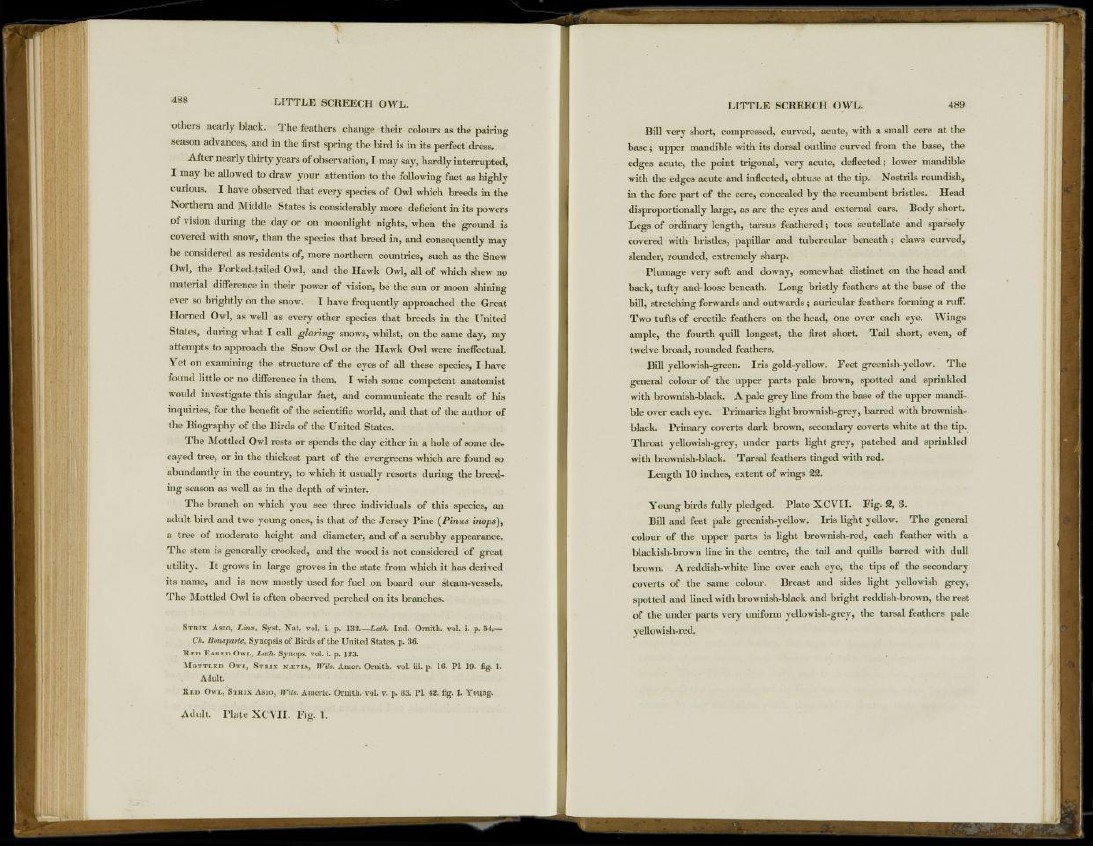
488 LITTLE SCREECH OWL.
others nearly black. The feathers change their colours as the pairingseason
advances, and in the first spring the bird is in its perfect dress.
After nearly thirty years of observation, I may say, hardly interrupted,
I may be allowed to draw your attention to the following fact as highly
curious. I have observed that every species of Owl which breeds in the
Northern and Middle States is considerably more deficient in its powers
of vision during the day or on moonlight nights, when the ground is
covered with snow, than the species that breed in, and consequently may
be considered as residents of, more northern countries, such as the Snow
Owl, the Forked-tailed Owl, and the Hawk Owl, all of which shew no
material difference in their power of vision, be the sun or moon shining
ever so brightly on the snow. I have frequently approached the Great
Horned Owl, as well as every other species that breeds in the United
States, during what I call glaring snows, whilst, on the same day, my
attempts to approach the Snow Owl or the Hawk Owl were ineffectual.
Yet on examining the structure of the eyes of all these species, I have
found little or no difference in them. I wish some competent anatomist
would investigate this singular fact, and communicate the result of his
inquiries, for the benefit of the scientific world, and that of the author of
the Biography of the Birds of the United States.
The Mottled Owl rests or spends the day either in a hole of some decayed
tree, or in the thickest part of the evergreens which are found so
abundantly in the country, to which it usually resorts during the breeding
season as well as in the depth of winter.
The branch on which you see three individuals of this species, an
adult bird and two young ones, is that of the Jersey Pine (Pinus inops),
a tree of moderate height and diameter, and of a scrubby appearance.
The stem is generally crooked, and the wood is not considered of great
utility. It grows in large groves in the state from which it has derived
its name, and is now mostly used for fuel on board our steam-vessels,
The Mottled Owl is often observed perched on its branches.
STRIX ASIO, Linn, Syst. Nat, vol. i. p. 132—Lath. Ind. Ornith. vol. i. p. 5 4 ,—
Ch. Bonaparte, Synopsis of Birds of the United States, p. 3 6 .
B E D EARED OWL, Latlu Synops. vol. i. p. 1 2 3 .
MOTTLED OWL, STRIX N^EVIA, IVils. Amer. Ornith. vol. iii. p. 16. PI. 19. fig. 1'.
Adult.
BED OWL, STRIX ASIO, mis. Americ Ornith. vol. v. p. 8 3 . PI. 12. fig. I. Young.
Adult. Plate XCVII. Fig. t.
LITTLE SCREECH OWL. 489
Bill very short, compressed, curved, acute, with a small cere at the
base; upper mandible with its dorsal outline curved from the base, the
edges acute, the point trigonal, very acute, deflected; lower mandible
with the edges acute and inflected, obtuse at the tip. Nostrils roundish,
in the fore part of the cere, concealed by the recumbent bristles. Head
disproportionally large, as are the eyes and external ears. Body short.
Legs of ordinary length, tarsus feathered; toes scutellate and sparsely
covered with bristles, papillar and tubercular beneath; claws curved,
slender, rounded, extremely sharp.
Plumage very soft and downy, somewhat distinct on the head and
back, tufty and-loose beneath. Long bristly feathers at the base of the
bill, stretching forwards and outwards; auricular feathers forming a ruff.
Two tufts of erectile feathers on the head, one over each eye. Wings
ample, the fourth quill longest, the first short. Tail short, even, of
twelve broad, rounded feathers.
Bill yellowish-green. Iris gold-yellow. Feet greenish-yellow. The
general colour of the upper parts pale brown, spotted and sprinkled
with brownish-black. A pale grey line from the base of the upper mandible
over each eye. Primaries light brownish-grey, barred with brownishblack.
Primary coverts dark brown, secondary coverts white at the tip.
Throat yellowish-grey, under parts light grey, patched and sprinkled
with brownish-black. Tarsal feathers tinged with red.
Length 10 inches, extent of wings 22.
Young birds fully pledged. Plate XCVII. Fig. 2 , 3.
Bill and feet pale greenish-yellow. Iris light yellow. The general
colour of the upper parts is light brownish-red, each feather with a
blackish-brown line in the centre, the tail and quills barred with dull
brown. A reddish-white line over each eye, the tips of the secondary
coverts of the same colour. Breast and sides light yellowish grey,
spotted and lined with brownish-black and bright reddish-brown, the rest
of the under parts very uniform yellowish-grey, the tarsal feathers pale
yellowish-red.